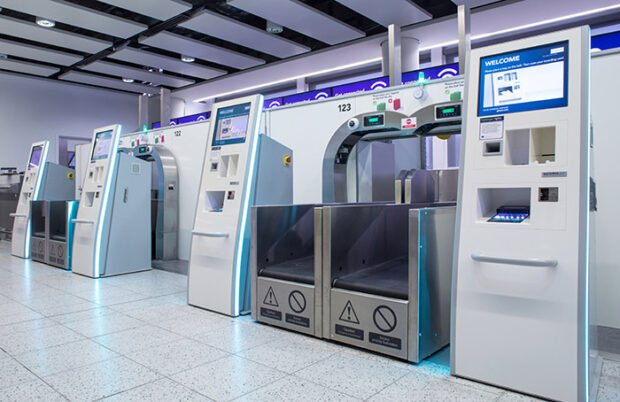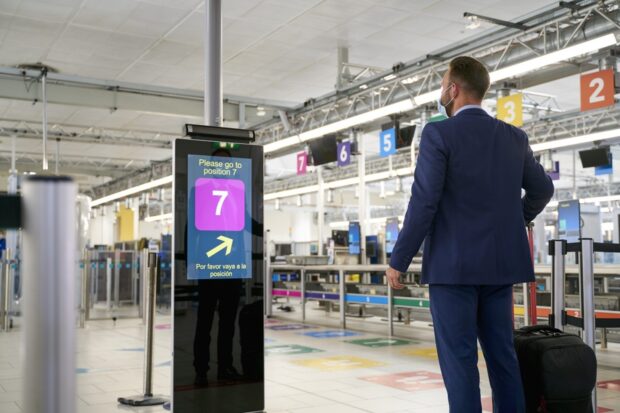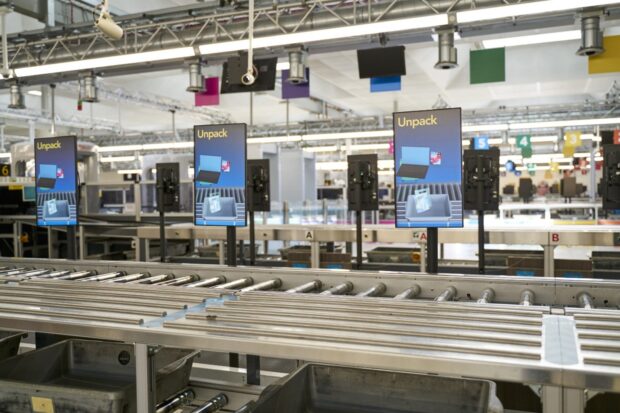MIAC bares more details on NAIA Rehab
Solving the Ninoy Aquino International Airport’s (NAIA) issues will prove to be a complex undertaking.
The Philippines’ primary international gateway has, especially in recent years, been beleaguered with complaints from both local and foreign travelers. From long lines to crippling power outages, lengthy flight delays to overcrowded facilities—the list of snags and hitches faced by the NAIA seem only to be getting longer. However, as in an iceberg, many of these represent just the tip.

Part of MIAC’s plan is to transform security screenings at the NAIA by installing next-generation security lanes, similar to the ones at Gatwick Airport (pictured), another GIP-operated airport.
Accelerating change in NAIA
To address NAIA’s challenges and precipitate its renewal, the Manila International Airport Consortium (MIAC) has proposed a total project cost of approximately PHP 267 billion in the Unsolicited Proposal (USP) for the rehabilitation and modernization of NAIA which it had submitted to the government last April. Higher than other estimates and projections, the level of investment envisioned by the Consortium confirms its iron-clad commitment to the project—as well as its belief in the potential of NAIA as well as of Mega Manila and the Philippines as a whole.
MIAC is composed of six of the largest Filipino conglomerates—namely, Aboitiz InfraCapital, Inc., AC Infrastructure Holdings Corporation, Asia’s Emerging Dragon Corporation, Alliance Global – Infracorp Development Inc., Filinvest Development Corporation, and JG Summit Infrastructure Holdings Corporation—and US-based Global Infrastructure Partners (GIP), a global, independent infrastructure fund manager and one of the largest non-listed airport operators in the world.
MIAC’s proposed project cost reverses the effects of the chronic underinvestment in NAIA over the past 20 years, which has been the main culprit for its current state. This lack of investment has led to NAIA’s facilities becoming outdated and, at times, even non-operational. Many of its electrical equipment need repair or replacement, including elevators, air-conditioning systems, air bridges, check-in counters, and baggage handling systems. The airport’s equipment for both passengers and aircrafts requires upgrades. Furthermore, the actual protocols for handling passengers need to be reviewed for efficiencies.
Multi-airport strategy requires long-term view
Currently, the NAIA is already operating beyond its stated capacity of 31 million passengers per annum (MPPA). Meanwhile, the air traffic demand for the Manila Airport System is expected to already reach 100 MPPA by 2036, and even exceed 150 MPPA in 30 years.
As NAIA is the only airport currently serving Mega Manila, MIAC believes that it will play a critical role in establishing a multi-airport strategy for the region. All over the world, many large metropolitan areas which, like Mega Manila, has a population of more than 20 million people, are serviced by two or even three airports. These include ASEAN peers such as Bangkok and Jakarta alongside more developed cities such as Tokyo and Beijing.

MIAC plans to help solve the NAIA’s long queues by investing in systems and technologies similar to the ones GIP has introduced at Gatwick Airport in London (pictured).
MIAC believes that the NAIA will continue to play a critical role in the growth of Mega Manila and the Philippines and advocates for a comprehensive and long-term approach to its rehabilitation. This will also bring much needed airport redundancy to address Mega Manila’s disaster- and earthquake-prone environment—the region requires several airports, especially at least one not on reclaimed land.
It is imperative, therefore, that the NAIA be rehabilitated and modernized in parallel with the development of new greenfield airports. While the latter are still being constructed, an upgraded NAIA will ensure continuous servicing of Mega Manila’s air travel needs in the next decade or so when it will still be the region’s only airport. Upon the completion of the greenfield airports, NAIA will still be needed to complement these for the airport system to handle the explosive air travel demand projected for the region.
25-year concession to temper rise in passenger fees and ensure long-term commitment
A 25-year concession ensure long-term commitment and investment into NAIA and will help maintain relatively lower passenger fees. NAIA currently has one of the lowest airport fees not only in the region but in the world. A longer concession period will help ensure that this remains to be the case in the foreseeable future, even as NAIA’s passenger fees become on par with Mactan Cebu International Airport.
Apart from a sizeable investment, delivering comprehensive changes to NAIA will also require a long horizon. A 15-year concession period, for instance, will bring less capital investment to the airport, resulting in lower capacity and service improvements—a band-aid solution rather than the complete rehabilitation that it urgently needs. A shorter concession period will also mean less economic benefits: less concession payments to the government, fewer jobs created, and less tourism uplift.
High chances of success with super consortium and its PHP 57B upfront payment
Given the scale and scope of the rehabilitation and update that the NAIA requires, it is important that the one which will undertake it be a credible organization with the requisite experience and track record, especially in the PPP and airport space.
For MIAC, the proof of their commitment is the proposed PHP 57 billion upfront concession payment to the Philippine government—the largest ever offered for a transportation Public-Private Partnership (PPP) in the country. The upfront concession payment—frequently used as a parameter in many PPP bids—offered by MIAC will not only contribute to the country’s fiscal space but also demonstrates the Consortium’s commitment and willingness to dedicate resources to transforming NAIA into an international hub.
Contrary to previous speculations, the proposal has no real estate component as the airport and land will remain under government ownership. For the local consortium members, their individual investment is relatively small in comparison to their respective portfolios. Their major objective is to ensure that the country’s growth will not be choked by a poorly managed international gateway and that the airport will be in the hands of a reliable team and capable operator..
A comprehensive and integrated plan by an experienced airport operator
Investments in upgraded equipment on its own will not ensure a high performing airport. A strong experienced O&M team is required to deliver the changes for both landside and airside problems.
MIAC—collectively and individually—has robust credentials and is well-placed to take on the rehabilitation. Several local members of the Consortium have extensive track records in operating and delivering large-scale infrastructure PPPs, including in transportation. This includes household names in air transportation such as the Mactan Cebu International Airport, Clark International Airport, Philippine Airlines, and Cebu Pacific. This collective experience enables MIAC to navigate local nuances with nimbleness, making it well-positioned to address potential challenges or ambiguities, whether technical, operational, regulatory, or otherwise.
Moreover, GIP, the technical partner, has a portfolio which includes Sydney Airport, Gatwick Airport, and Edinburgh Airport—airports of similar size as the NAIA which have been recognized as some of the world’s highest-performing airports of its class. GIP has consistently proven its expertise in maximizing the utilization of its airports’ footprint, enabling these to process a large volume of passengers as well as aircrafts in their relatively smaller-scaled terminals—an approach that would best suit and benefit NAIA’s present configuration.
Landside: digitalization and operations excellence to improve passenger experience
From the studies of the NAIA which MIAC conducted, one of the conclusions the Consortium has drawn was that the airport was not badly built, only poorly optimized, at least in its current configuration.
As part of its multi-phased Masterplan, the Consortium plans to tackle three main things as part of its “Quick Wins,” the first phase of which will be implemented in the first two years of the concession, as part of efforts to introduce efficiencies.
The first item it plans to tackle are NAIA’s long queues which the Consortium aims to solve by investing in systems and technologies. This will include digital, automated, and modern equipment such as common user check-in counters. Airline-agnostic, these counters can be used for both local and international flights and will allow travelers to check in without any human interaction, using their passport and ticket—even soft copies of the latter on their smartphones—to have their information read and processed by self-service machines. These will be complemented by self-bag drops which will further cut down unnecessary interactions and quicken the process.

MIAC plans to introduce the latest in screening technology in NAIA, similar to those deployed in other GIP-operated airports. This is intended to make passenger processing more efficient and shorten queuing times.
The latest in screening technology will also be introduced. Passengers can walk straight through the screening area without the need to have their photo taken or to turn around, which is the practice in older, less advanced airports. Bag screening will also be improved: no need to take out laptops, dopp kits or liquids. One can just put one’s bag into a machine and walk through without stopping—not even to take off one’s shoes and belt.
Passenger segmentation and profiling will also be improved to improve passenger processing. Passengers with needs will be grouped together in the same queues. This will enable the faster processing of majority of passengers, which usually have less requirements to travel.
Many of these improvements have been previously rolled out by GIP in several of its airports, most notably at Gatwick Airport in London, which has set for itself a target of processing 95% of all passenger journeys in five minutes or less through its screening areas. In other words, passengers can get from the front door to the terminal shops in five minutes. Using the experience and knowledge GIP has gained in implementing these, MIAC foresees that while NAIA’s shortened processing times will still be modest compared to those in other GIP-run airports, its aim of cutting down current queue times to more than half within the next two years will still prove to be transformational for many travelers.
Through these, MIAC aims to increase the NAIA’s passenger capacity to 54 MPPA by 2025. In the long-term, MIAC plans to also introduce terminal expansions during the latter phases of its Masterplan and raise capacity even further to approximately 70 MPPA.
Airside: shortening runway queues
Similarly, after GIP took over the operations of Gatwick Airport—the world’s busiest single-runway airport—it was able to lift Gatwick Airport’s runway capacity from 50 ATMs/hour to 55 ATMs/hour after only four years. While Gatwick Airport’s runway structure is different to the NAIA’s, it is functionally very similar—cross runways essentially function as single runways as only one can be operated at any given time.
Aircraft queuing, while less visible to passengers, tangibly affects their over-all airport experience, if not their whole journey. To address this, MIAC is looking to increase the number of aircraft stands and air bridges at the NAIA.
At present, the NAIA has a chronic shortage of places to park aircrafts, which is done either on area bridges or on remote stands. In its Masterplan, the Consortium proposes to nearly double the number of aircraft stands in NAIA to allow for the easier movement of aircrafts as well to increase aircraft movements per hour (ATMs/hour)—the number of take-offs and landings in an hour.
Lastly, MIAC aims to optimize the NAIA’s cross-runway system, which consists of two intersecting runways. Contrary to some misconceptions, this type of runway structure is not an inherent capacity constraint. LaGuardia Airport in New York, for instance, which also operates a cross runway, has been able to get its capacity up to 74 ATMs/hour. For comparison, the NAIA’s capacity is currently capped at 41 ATMs/hour.
MIAC is looking to apply similar optimizations that GIP was able to introduce at Gatwick as well as in its other airports. These include creating new taxiways, improving procedures for the air traffic control provider, and bettering airspace planning and aircraft sequencing. With these, MIAC aims to increase NAIA’s runway capacity to up to 55 ATMs/hour over time.
MIAC: prepared to solve NAIA’s problems
MIAC has completed various studies which includes traffic, technical, and ESG studies and has its financing lined up in preparation for its shovel-ready solution. MIAC recognizes the urgency of the situation and is ready to act swiftly and implement its solution as early as this year.
MIAC has come to the table prepared, ready to unpick the NAIA’s challenges and begin its transformation into the international airport hub that Filipinos—and Philippine visitors—need and deserve.
ADVT.